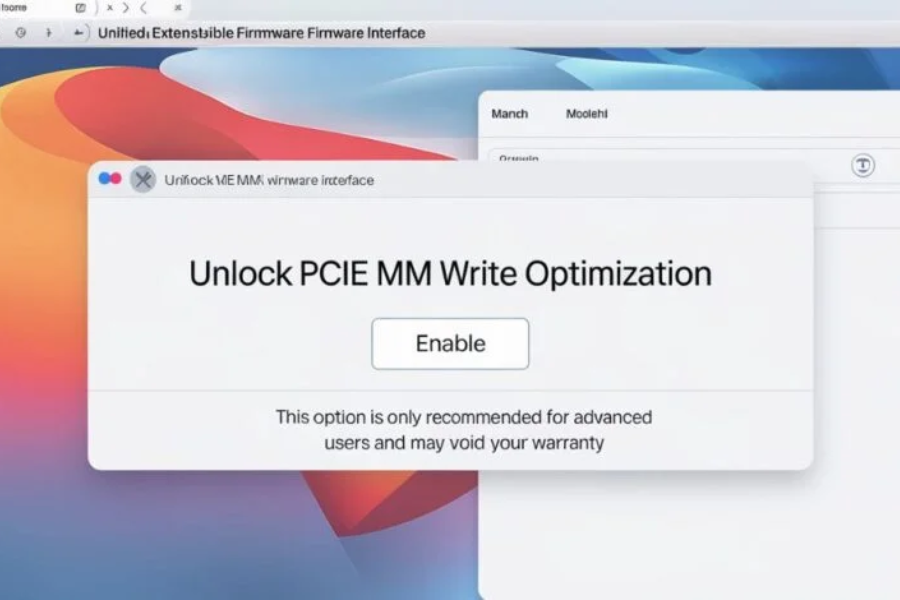Introduction
Understanding the intricacies of hardware parameters can significantly enhance your device’s performance, and one such parameter is the PCIe MM Write UEFI setting. This guide delves into the details of PCIe MM Write in UEFI firmware, highlighting its advantages and how to fine-tune specific settings for improved system performance. A grasp of this technology is essential for boosting speed and optimizing communication between your components. Let’s simplify the process to help you optimize your setup effectively.
Understanding PCIe MM Write in UEFI
PCIe MM Write UEFI refers to a feature that enables PCIe (Peripheral Component Interconnect Express) devices to write data directly to designated memory addresses. This capability enhances the efficiency of data transfers within connected systems, managed under the UEFI firmware that governs system interactions at this level. By completing MM Write operations through PCIe, you can significantly improve the data rates of your hardware components. Optimizing this setting can lead to noticeable enhancements in performance, particularly in demanding tasks like gaming, video rendering, and data transfer.
Why PCIe MM Write Optimization Matters
Properly configuring PCIe MM Write UEFI can dramatically boost your system’s performance. This optimization minimizes congestion in data flow between the CPU, GPU, and other PCIe-connected devices. While using this feature brings benefits, neglecting it can result in slower system performance and reduced bandwidth. Users engaged in resource-intensive tasks—such as CAD, gaming, or software development—will particularly benefit from these enhancements.
How UEFI Firmware Controls PCIe MM Write
The UEFI (Unified Extensible Firmware Interface) represents a modern evolution of traditional BIOS firmware. It offers advanced settings and improved compatibility with contemporary hardware. Within UEFI, users can manage PCIe MM Write parameters, which define how devices interact, allowing for enhanced control over memory mapping and data transfer rates. This direct access to settings enables users to optimize hardware performance without relying on additional software interfaces.
Benefits of Tuning PCIe MM Write in UEFI
Optimizing PCIe MM Write UEFI offers several advantages beyond mere performance boosts. First, it enhances data transfer speeds, leading to quicker loading and processing times. Additionally, it reduces I/O latency, which is especially beneficial for time-sensitive applications like video streaming and 3D rendering. Furthermore, fine-tuning these settings can contribute to power savings; excessive CPU usage can waste resources, while optimized configurations create a smoother, more energy-efficient user experience.
Steps to Configure PCIe MM Write in UEFI
Configuring the PCIe MM Write UEFI settings is straightforward, though it requires some technical know-how. Begin by powering down your computer, then restart it and enter the UEFI firmware settings using a designated hotkey—commonly F2, Del, or Esc. Navigate to the “Advanced” or “PCI Configuration” tab, where you’ll find the PCIe MM Write option. Depending on your motherboard, you may need to enable this setting or confirm that it’s already active. After adjusting the settings, be sure to save your changes before exiting the UEFI interface, allowing your system to reboot with the new configurations.
Troubleshooting PCIe MM Write Issues in UEFI
Changes to PCIe MM Write settings can occasionally lead to system instability or hardware malfunctions. If issues arise, both Windows 7 and Windows 8 offer options for reverting to default settings. Additionally, updating your firmware through UEFI can resolve compatibility issues, particularly with new hardware. For troubleshooting assistance, seeking guidance from specific forums or manufacturer resources can provide valuable insights into error resolution.
FAQs
How does PCIe MM Write improve performance?
It minimizes data transfer latency and accelerates communication between PCIe devices.
Can adjusting PCIe MM Write cause harm to my system?
Cautious changes are unlikely to result in permanent damage.
Where are PCIe MM Write settings located in UEFI?
Typically found under the “Advanced” or “PCI Configuration” tab.
Does every system support PCIe MM Write adjustments?
No, some motherboards may lack access to these settings within UEFI.
Is updating UEFI necessary before adjusting PCIe MM Write?
While it’s not mandatory, an update is recommended for optimal compatibility with newer hardware.
Conclusion
Enhancing the PCIe MM Write UEFI settings is crucial for maximizing your system’s efficiency, particularly for users seeking peak performance. This optimization is vital for complex computational tasks. By fine-tuning these settings, you can improve data transfer rates, reduce latency, and achieve effective coordination among your hardware components. Whether you’re a gamer, software developer, or a power user, understanding PCIe MM Write in UEFI can significantly elevate your system’s performance. Fine-tuning this feature offers a substantial boost to your overall operational efficiency.




Leave a Reply